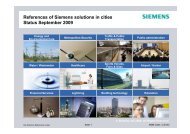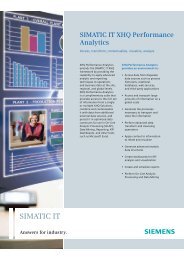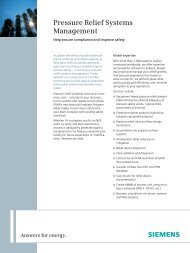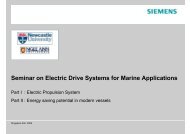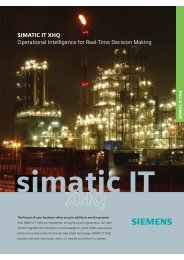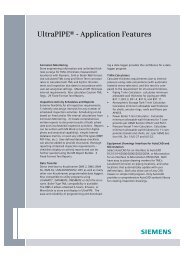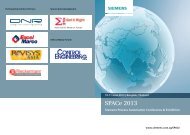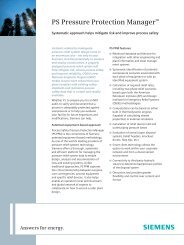Wireless Flexibility - Siemens
Wireless Flexibility - Siemens
Wireless Flexibility - Siemens
Create successful ePaper yourself
Turn your PDF publications into a flip-book with our unique Google optimized e-Paper software.
P r o d u c t s<br />
T e l e S e r v i c e<br />
p Simatic TeleService: Remote maintenance via modem<br />
Covering the Distance<br />
With Simatic TeleService, remote servicing of Simatic S7 Automation<br />
Systems (AS) or Human Machine Interface (HMI) devices is possible<br />
using the programming device or Personal Computer (PC) over a fixed<br />
line or wireless network.<br />
With the help of Simatic TeleService, the<br />
connection to the automation components<br />
is extended over the telephone<br />
network to the programming device or PC. The functions<br />
to be performed, such as programming, are<br />
completed using the same tools and functionality as<br />
if the job is done locally. The user has access to the familiar<br />
functions of STEP 7 and the Engineering Tools,<br />
comparable to a local connection.<br />
TeleService Adapter II is supporting Bus connections<br />
to Multipoint Interface (MPI), Profibus DP up to<br />
12Mbit/s, Point-to-Point Interface (PPI) and TeleSer-<br />
T S A d a p t e r a n d B u s C o n n e c t i o n s<br />
vice Adapter IE to Industrial Ethernet<br />
(IE) and Profinet.<br />
Simatic TeleService extends the bus<br />
interface via the telephone network to<br />
access remote CPUs (S7- 200, -300, -<br />
400, C7, WinAC) with STEP7, ProTool,<br />
and all Simatic programming tools.<br />
Therefore no PG/PC is required on-site<br />
at the plant.<br />
The TS Adapter IE supports also remote<br />
maintenance of Simatic HMI operator<br />
panels via WinCC flexible with<br />
Sm@rtService or an Internet Browser<br />
installed on the PC/PG.<br />
Parameterization and secured access<br />
<strong>Siemens</strong> AG<br />
The Simatic TeleService<br />
adapter module<br />
Adapter Bus<br />
Connection<br />
TeleService Adapter II TeleServce Adapter IE<br />
Analog ISDN Analog ISDN<br />
MPI = =<br />
Profibus = =<br />
PPI = =<br />
PROFINET = =<br />
Industrial<br />
Ethernet<br />
= =<br />
S i m a t i c T e l e S e r v i c e<br />
Simatic TeleService consists of integrated components<br />
3 TeleService Adapter II / IE<br />
3 TeleService Software V6.1 (stand-alone software)<br />
3 Function blocks (FBs) for remote maintenance, remote<br />
coupling, alarm using text messages(SMS), by e-mail or fax<br />
The connection to the automation systems is established<br />
using existing communication networks:<br />
3 Analog telephone network<br />
3 ISDN<br />
3 Mobile telephone network<br />
TeleService software V6.1 is used for the local parameterization<br />
of the Adapters. The TS Adapter IE can<br />
also be parameterized over a Remote Link or Internet<br />
Browser.<br />
Access is possible only via dial-in. The TS Adapter<br />
IE comes with a pre-configured firewall. By default<br />
the firewall only permits Simatic services. The required<br />
services, e.g. Sm@rt-Access, Sm@rt Service,<br />
can be enabled via the integrated Web interface of<br />
the Adapter.<br />
Cost-effective anytime anywhere access<br />
Simatic TeleService offers a low-cost, easy to handle<br />
application resulting to a shorter service time, less<br />
maintenance and operational costs (less travel expenses,<br />
lower on-call/onsite requirements, less configuration<br />
hassles).<br />
Remote access through Simatic TeleService enables<br />
the user to access and perform maintenance for<br />
Simatic PLCs, HMI and remote coupling from a central<br />
service center effecting an “anytime, anywhere”<br />
access to plants and machines. <br />
p<br />
info<br />
contact<br />
www.siemens.com/simatic/industriesoftware<br />
christian.kopplin@siemens.com<br />
ideas singapore | 2008 19



